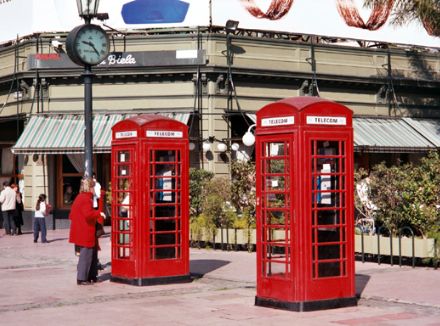Arts & Culture
About Andrew Cusack
 Writer, web designer, etc.; born in New York; educated in Argentina, Scotland, and South Africa; now based in London.
Writer, web designer, etc.; born in New York; educated in Argentina, Scotland, and South Africa; now based in London. read more
News
Blogs
Reviews & Periodicals
Arts & Design
World
France
Mitteleuropa
Knickerbockers
Argentina
The Levant
Africa
Cape of Good Hope
Netherlands
Scandinavia
Québec
India
Muscovy
Germany
Academica
Flags of the British Nations
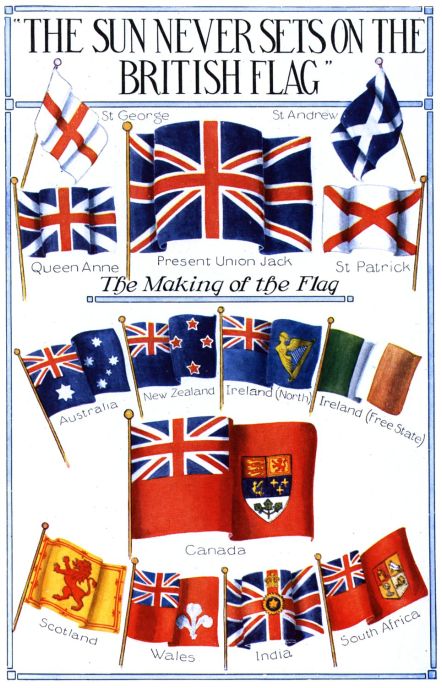
It is interesting how little-valued accuracy was in the depiction of flags “back in the day”. In this illustration, for example, the flags of Wales and “Ireland (North)” are mere inventions while the Scottish and Indian ones are arguable yet imprecise.
The “Welsh” flag depicted is a red ensign that is defaced with the three feathers of the Prince of Wales.
The “Ireland (North)” flag is handsome, but nonexistent. Northern Ireland had an official flag in use from 1953 until the Parliament of Northern Ireland was prorogued in 1972. (It was never recalled, and has since been superseded by the Northern Ireland Assembly). The flag of “Norn Iron” was a banner of the province’s coat of arms.
The flag of Scotland shown here is not actually the national flag (depicted above as the “St. Andrew” flag) but rather the Scottish royal standard, which is often (and improperly) used as an alternative national flag.
The Indian flag depicted is actually the flag of the Viceroy of India, which (admittedly) was sometimes used as a national flag for India. More often, however, a blue or red ensign was used, defaced with the Star of India.
The Canadian flag depicted here was changed in 1957, when the arms of Canada were themselves changed. The maple leaves in the bottom compartment of the sheild were specified to be “gules” (red). Up to that point, they had previously almost always been rendered “vert” (green). The Canadian flag itself was very controversially and unpopularly replaced by Prime Minister Lester B. Pearson with the Maple Leaf Flag. The Leader of the Opposition, the Rt. Hon. John Diefenbaker, derided the Liberal premier’s decision:
“We have had a flag. Flags can be changed. But flags cannot be imposed — the sacred symbols of a people’s hopes and aspirations — by the simple capricious personal choice of a prime minister of Canada. Now then, whenever the overwhelming majority of Canadian people want a new version, and when the design is meaningful and acceptable to most Canadians, that’s democracy. … I asked him [Prime Minister Pearson] this question: as to whether or not, under the circumstance, he would permit or he would arrange for a national referendum and his answer was no.”
Attack of the Killer Poets
The gentlefolks’ aortas will gush without me.
The last chance to get stained with blood
I let go by.
Ever more often I answer ancient calls
And watch the mountains turn green.
Aeschylus fought at Marathon, Maecenas rode with Octavian, and even Coleridge had a spell in the Dragoons (under the assumed name of Silas Tomkyn Combebach), yet more recent examples of convergence between the realms of the poetical and the military leave something to be desired. The above quotation is a mere snippet from the works of Radovan Karadžić, sometime leader of the Bosnian Serb forces during the disintegration of Yugoslavia. As a Hungarian friend said recently, “If that doesn’t get him sent to the Hague, I don’t know what will!”
Misery loving company, Karadzic invited Eduard Limonov, the Russian poet, writer, and all-around nasty character, to Bosnia in the midst of the Seige of Sarajevo. This brief YouTube clip shows the two poets inspecting a Serb position overlooking the town. The tousled-haired Karadzic gloats over the woebegone metropolis while Limonov takes aim at a few civilians through the sight of a sniper rifle before opening fire. (Limonov returned to Mother Russia, where he founded the National Bolshevik, or “Nazbol” party. Is there no Russian Wodehouse to ridicule this strange band of neo-Hitlerite Stalin-worshippers? “Spagbol” seems an obvious equivalent of Roderick Spode’s Black Shorts.)
Meanwhile, we read in the feuilleton of today’s Süddeutsche Zeitung (via signandsight.com) that German authorities have refused to grant asylum to the Chechen poet Apti Bisultanov. Bisultanov, as it turns out, led a unit of thirty-five men during the Battle of Grozny and has been accused of a number of war crimes and human rights violations.
Kinda makes you wonder what nefarious plots are being hatched when David Yezzi meets Ben Downing for a drink at the Old Town.
[Cross-posted at Armavirumque]
‘Titus’
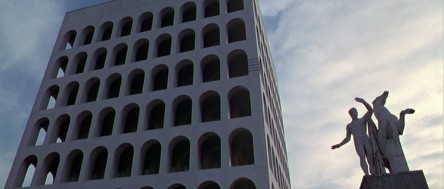
JULIE TAYMOR’S VERSION of Shakespeare’s “Titus Andronicus”, the 1999 film “Titus” (with Anthony Hopkins in the title role), is a rather interesting modern interpretation. It has rather whimsical aspects, such as the ‘SPQR News’ microphone the characters are seen speaking into. The rivals for the imperial throne bedeck their supporters in the colors of Rome’s rival football teams: the red and yellow of Roma for Saturninus and the pale blue and white of Lazio for Bassianus. I especially enjoy the Senators bedecked in old-school white suits making them appear like a convivium of Kentucky colonels. Worth seeing.
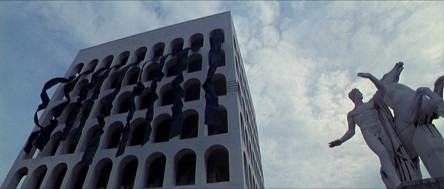
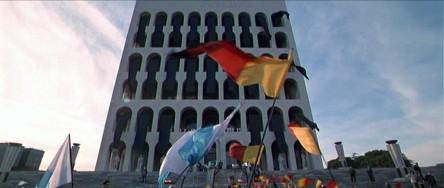
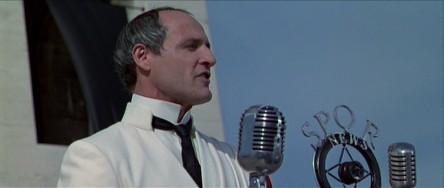
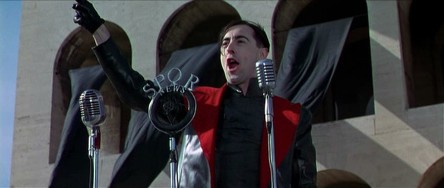
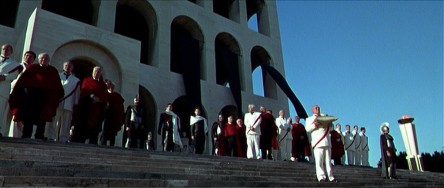
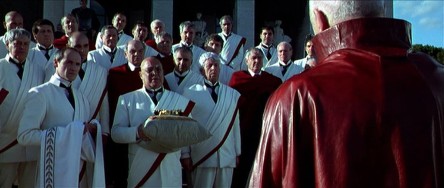
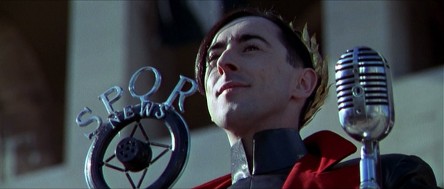
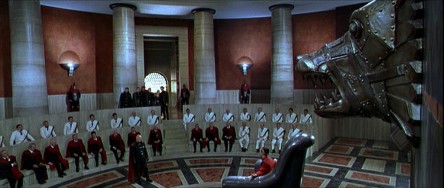
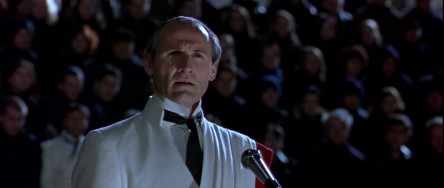
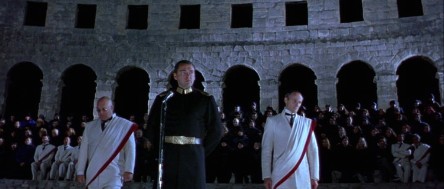
Lord Glenavy

Sir James Henry Mussen Campbell, Bt., 1st Baron Glenavy, PC, QC. was born in Dublin in 1851. Campbell graduated from the University of Dublin (Trinity College) a Bachelor of the Arts in 1874. He was called to the Irish bar in 1878, being made a Queen’s Counsel in 1892.
Campbell was elected to Parliament in 1898, being called to the English bar a year later. He was made Solicitor General for Ireland in 1903, as well as being appointed an Irish Privy Counsellor. He rose to become Lord Chief Justice of Ireland in 1916, being made a baronet the following year, and Lord Chancellor of Ireland the year after that (1918). Sir James was ennobled as 1st Baron Glenavy upon relinquishing office in 1921.
Ireland was partitioned in the following year, and Lord Glenavy became the first Cathaoirleach of Seanad Éireann (Presiding officer of the Irish senate). In 1923, he chaired the judicial committee investigating the establishment of a new courts system for the Irish Free State. His proposals were implemented the following year in the Courts of Justice Act 1924, forming the Irish courts as they remain today.
Having served one six-year term in the Seanad, he did not seek re-election in 1928, and died three years later in 1931. Holding the largely honorary position of President of the College Historical Society (“the Hist”), Dublin University’s debating society, from 1925, he was succeeded upon his death by his fellow Irish Protestant, Douglas Hyde, who himself later became the first President of Ireland from 1938 until 1945.
The Men Who Saved Quebec
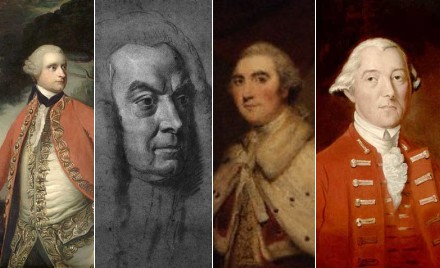
The British Crown’s toleration of Catholicism in Quebec was cited by the rebel colonists of the 1770’s as, ironically, an ‘intolerable act’. That the Church of Rome, that bastion of backwards conservatism and slavish hierarchy, could be tolerated in the lands under the power of the British parliament riled the Whigs—the enlightened liberal progressives of the day. Indeed, Benjamin Franklin was even so foolish as to go to Quebec as an emissary of the ‘Continental Congress’ to persuade the natives to rebel against the Crown; Congress’s proposals to ban Catholicism and prohibit the use of the French language ensured he was not successful.
The modern orthodox opinion of historians on the Quebec Act of 1774—the act that granted toleration to the Church—is that it was merely a persuasive exercise to keep les Canadiens from rebelling. A 1989 book challenged this perspective, arguing instead that a handful of British aristocrats were determined to ensure that Quebec did not become another Ireland: where Protestant ascendancy was thrust upon an unwilling nation of Catholic nobles, merchants, and peasants.
The following review by Gary Caldwell was published in a Canadian journal in 2001.
|
Philip Lawson.
The Imperial Challenge: Quebec and Britain in the Age of the American Revolution. Montreal and Kingston: McGill-Queen’s University Press. 192 pages. US$27.95. |
WHY REVIEW A BOOK published twelve years ago? I will explain. But first, let me tell you what it’s about.
When Britain took possession of Canada at the Treaty of Versailles in 1763, it faced an “imperial challenge:” how to integrate into the empire a society fundamentally different from England – in language, religion, and legal and political institutions. At the time, England was vigorously intolerant of Roman Catholicism or “popery,” the religion of its major enemies, France and Spain. British Protestantism was closely tied to the dominant Whig political ideology born of the Glorious Revolution of 1688-89. This doctrinal legacy prescribed that all British subjects were possessed of very definite and equal liberties, liberties endowed upon and limited to those who conformed to the Whig-Protestant definition of being British.
Hence the problem of 1763. English law and constitutional practice allowed only for protestant public officials and elected representatives. This meant excluding the entire French-speaking population, some 70,000 to 80,000 (the “new subjects”) as compared to some 300 Protestants established in the colony (the “old subjects”).
There were two schools of thought as to what should be done. The Whig position, favoured by much of the English political leadership and commercial class on both sides of the Atlantic, was not to accommodate the new subjects. It amounted to an attempted destruction of the local culture and to exclusion of the French-speaking population from all juridical, political and social positions, the hoped-for consequence being assimilation in one, perhaps two, generations. In short, what had been imposed in Ireland with the “protestant ascendancy.”
The opposing school of thought, still marginal in 1763, believed such a policy both impracticable and undesirable. James Murray, Lord Shelburne, Lord Dorchester (Gary Carleton), H. T. Cramahe, Alexander Wedderburn, Lord Mansfield and William Knox not only held that a Protestant ascendancy in Quebec would ruin the colony, they also believed that Quebec society was deserving of being preserved. Murray and Dorchester, who knew Quebec and its people, were adamant: the Canadians were a good “race”—in Murray’s words, “perhaps the best and bravest race on the globe” (p. 48)—and if protected they and their society would flourish and be loyal to the Crown. As it happened, all of these administrators and Crown legal officers, with the exception of Cramahe, were Anglo-Irish or Scottish; not one of them was of English origin.
But how were the Canadians and their culture to be accommodated? There were, as Lawson demonstrates, three distinct dimensions to this accommodation. The first was to respect the prevailing legal code and custom in civil and property matters; the second, to refrain from putting into place an English representative assembly because it would be the instrument of the 300 or so English and American voters in the colony. By far the most important was the third dimension, tolerance in Quebec of Roman Catholicism, which meant the nomination of a Bishop, the tithe and the right of Catholics to hold public office. Dorchester and the others successfully won these concessions in London by 1770, and they were contained in the Quebec Act in 1774, to the horror of much of English public sentiment, and especially the Americans who were more resolutely against “popery” and more Whig than the English themselves.
When Benjamin Franklin arrived in Montreal in 1775 with the invading army of the Continental Congress, he carried secret orders to ban the popish religion and the French language. Fortunately, the Americans were stopped in Quebec by no other than Dorchester, back from getting the Quebec Act through Parliament. At the head of an army of old and new subjects he broke the 1775-76 siege of Quebec.
Lawson’s interpretation is insightful in putting the events into the context of the Irish question. The major players in promoting the accommodation that became the Quebec Act had in mind “the Irish Imbroglio,” and were determined not to repeat the error of the “protestant ascendancy” in Ireland. The Quebec Act emerges clearly as the culmination of thoughtful and courageous policy formulation, a model of generous statesmanship. Hence, as Lawson goes on to argue, the “toleration” of Roman Catholicism in the Quebec Act paved the way for the British Acts of Toleration of 1778.
Lawson also helps understand why Murray, Dorchester and the others came to the conclusions they did about the Canathan problem. These men were essentially empirical conservatives who found the answer “in the past”—Quebec society as they had known it in the 1760s—and the “elastic nature of the British Constitution.” And here Lawson runs smack into the prevailing wisdom in Canadian historiography.
Lawson is insistent on the coincidental nature of any link between the Quebec Act and the American Revolution, affirming that there is no evidence that the inspiration for the Quebec Act was to placate the Canadians so as to keep them apart from the Americans. As this alleged link is one of the most tenacious myths in the Canadian historical consciousness, it is worth citing Lawson:
What can be done to dispose of this myth once and for all? Fifty years ago both Coupland and Burt said that they could find no evidence to justify such an assertion with Lanctot repeating the message in the 1960s, and nothing has yet come to light to contradict them (pp. 123-124).
When I first read this book in the early 1990s and realized how revolutionary his thesis was, I contacted Lawson to talk about his work. In passing, I mentioned that I supposed that The Imperial Challenge must have created quite a controversy in Canadian academic circles. His reply was “No, it has attracted very little attention in Canada.” (I never saw him again. I had arranged to see him a few years later, but just before I arrived in Edmonton he was admitted to hospital for terminal cancer and died shortly afterwards.) In subsequent years, I have been to McGill-Queens Press in Montreal to buy copies of his book to give to friends. Inquiring as to sales, I was told that only a few hundred copies had been sold. And, so far, I have encountered only one reference to Lawson’s book (in Yves Lamonde’s Histoire sociale des politiques au Quebec).
I was curious enough to go back recently to the reviews written when the book came out. There were 16 in Canada in French and English, in the United States and in the United Kingdom; all reviewers were quite positive except one (who wrote two of the reviews). They all commented positively on the extent and depth of the documentation, as well as the fresh reading from parliamentary debates, the personal archives of the principal players, and the press of the day. As for his interpretation of how the Quebec Act came to be, there is no suggestion that he was wrong in any respect. The negative reviewer suggests only that it is pretentious of Lawson to think he has added much to existing work on the Quebec Act. Of the 15 reviewers, a full half explicitly accredit Lawson with drawing out the intention of avoiding the error of Ireland.
Why, then, did a book, critically acclaimed by the author’s peers, which sheds considerable light on a pivotal period in the history of Quebec and Canada, drop out of sight in Quebec, and I suspect in the rest of Canada? Lawson calls into question the conventional wisdom on a very important subject in Canadian history, and no one takes notice. For instance, two prominent Canadians, Gerard Bouchard and John Raulston Saul, social thinkers who are presently reinterpreting Canadian history, make no mention, to my knowledge, of this book. A book that should have caused waves has generated scarcely a ripple.
Perhaps my assessment, as a non-professional historian, is faulty and I would welcome a demonstration of where I have erred. What are the factors that explain the untimely eclipse of Lawson’s work? Could it be simply that Canadian intellectual discourse is shallow, that a seminal work can be dropped into the water and hit bottom generating nothing more than a superficial ripple of perfunctory reviews and listings in compendiums? This is one possible explanation; a more certain explanation lies in ideology.
The ideological axe, starkly put, goes as follows. Quebec’s nationalist, republican-leaning contemporary intellectuals are loath to entertain the idea that a coterie of British Conservatives (half of them aristocrats) literally saved Quebec society by helping to keep it strong enough to withstand the renewed neo-liberal assault led by Lord Durham three quarters of a century later and, then, begin to rehabilitate the Quebec polity (under British institutions) in 1867. Such an idea being beyond the pale (again, the ghost of Ireland), they maintain the myth that the Quebec Act was political opportunism inspired by the American threat. What will it take for Quebec nationalist thinkers to recognize and appropriate the historical reality that Dorchester twice—in the Quebec Act and the siege of Quebec—saved Quebec? It is no exaggeration to assert that, had it not been for this one Anglo-Irish aristocrat, Quebec would likely have become anglicized and, subsequently, integrated into the American empire.
As for English-speaking Canada, the current crop of orthodox historians has long consigned our British imperialist past to the Marxist dust-heap of history: nothing good could possibly have come of it, all imperialisms being, by definition, bad. They are not about to disturb their orthodoxy that in contrast to Imperial Britain, which was incapable of any genuine sympathy for Quebec—only Canadian nationalist intellectuals are enlightened and respectful of Quebec society. So, they too maintain the “political opportunism” interpretation of the Quebec Act, despite its having been refuted by Lawson and his predecessors. Essentially, what we are seeing is a refusal to acknowledge a debt owed to dead white male Protestants (from Ireland and Scotland). But gratitude is not, as the contemporary French philosopher Alain Finkielkraut has pointed out, a hallmark of modern progressive thinkers.
I write this review knowing full well that it is too late for Lawson’s work to be rehabilitated. The Imperial Challenge is among the titles in this year’s McGill-Queen’s clear-the-warehouse sale.
Previously: Hitchcock in Quebec
Volcanic Hills Loom Over the Italian Bay
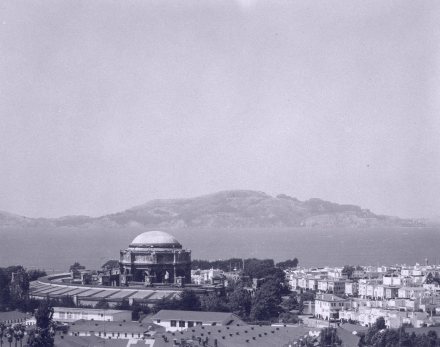
OR NOT, to be precise. I found the above view of San Francisco rather charming, a touch Neapolitan even, and decided to share it. The domed building is the Palace of Fine Arts, designed by Bernard Maybeck for the 1915 Panama-Pacific Exposition. It used to exhibit various works of art, but is now an “interactive” science museum. The Palace of Fine Arts was actually built to last only two years but the San Franciscans couldn’t bring themselves to tear it down. Eventually, the elements took their toll and in the 1960’s, it was torn down and completely rebuilt to the same external design but with a permanent structure. (more…)
‘To a Fishfinger’
 of our series introducing you to Peter Simple, the greatest columnist who ever was, we bring you this taste of the poetry of Julian Birdbath.
of our series introducing you to Peter Simple, the greatest columnist who ever was, we bring you this taste of the poetry of Julian Birdbath.
Birdbath is a character in the world of Peter Simple who lives at the bottom of a disused mine, alone but for his pet toad Amiel, writing poetry.
Among Birdbath’s putative translations of Esperanto verse is this delightful ode to the fishfinger – one of my favourite poems.
Thou shape impacted of Old Ocean’s heart,
With frost imbu’d and golden crumbs bedight,
Casual thy vending and thy worth too light:
How soon thy form symmetric must depart!
In rangéd boxes at the supermart
Thou bidest with thy fellows day and night,
Nor dream’st thou’ll’t scale some culinary height–
Who fries and serve thee needs no subtile art!
And yet for thee the stalwart seaman rov’d
’Mid tempests’ rage; and Iceland’s anger keen
Endur’d; nor glimpsed ’mid perils dire the end
Sublime: that thou, scorned digit, should’st be so lov’d
Dearer than pizza or th’ entinnéd bean,
For soliary men both food and friend!
edited and translated by Julian Birdbath
Hitchcock in Québec
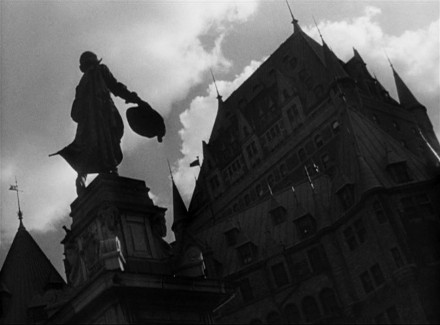
QUÉBEC, THAT STRANGE and charming province, is a most intriguing nation. It is where the British, French, and American tendencies clash and combine to form that most peculiar of all American varieties: le Québécois. Of course, since the 1960s Québec has become more French; no, not more French but more like France in that every year it plunges deeper into the depths of self-loathing: that hatred of one’s own tradition and history which has so marked out “the new Europe”. It is a race to assert one’s self by destroying any living connection to one’s past. Un jeu du fou. More’s the pity, as this once-vibrant melting pot of traditions expressed itself in interesting ways.
A splendid display of this Québec can be found in Alfred Hitchcock’s 1953 drama I Confess. The film had been recommended to me often and I finally got around to seeing it tonight. I won’t give away any of the plot, which is a good one, but Hitchcock lives up to his reputation with his excellent framing of the scenes. (Though I must admit, half of it is merely the settings in the Ville de Québec themselves). They include a peek into the Québécois Parliament. Above the Speaker’s dais is displayed not only the Sovereign’s arms, but also a crucifix, exhibiting our loyalties both temporal and spiritual. In the court room you find yet another blend of the Anglo and the French. As you no doubt recall from our handy little map, Quebec is a country with a mixed legal system. Founded as Nouvelle-France it had the civil system derived from the Romans. Captured by the British and later transformed into part of the Canadian Confederation, it has accrued layers of the Common Law so dear to we Anglos. The officials of the court wear British-style robes — the judge even has a tricorn hat — but over the jury looms a large crucifix. English government and French culture tempered by Catholic truth; not a bad mixture.
Anyhow, if you haven’t seen the film yet, here are a few snaps to enjoy until your Hitchcockian thirst is satiated. (more…)
Un Écossais en France
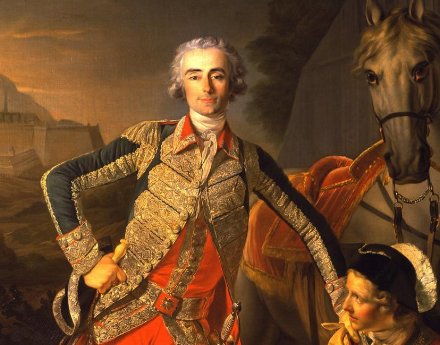
CHARLES GRANT, VICOMTE DE VAUX, was a Frenchman of Caledonian extraction who served as a sous-lieutenant in the Scots Company of the Garde du Roi, eventually rising to the rank of Lieutenant Colonel. A cadet branch of the Scottish clan, the Grants in France made sure to maintain links with their kinsmen in the old country. Abbé Peter Grant helped Sir James Grant, 8th Bt., commence an art collection while Sir James was on the Grand Tour in 1759-60. Abbé Grant’s nephew, Baron Grant de Blairfindy, was a fellow Catholic and Colonel in the Légion Royale of Louis XVI.
In a letter to Sir James, who was Chief of the Grants, Blairfindy described their fellow kinsman the Vicomte de Vaux as “a clever, brave officer, polite in company… as brave as his sword,” though, rather disappointingly, the Baron adds that the Vicomte “never drinks”. De Vaux himself took a keen interest in his extended family, and when the terrors of the French Revolution forced him into exile in London, he published there his Mémoires de la Maison Grant depicting the history of the clan. (more…)
A Sienese Gem Lost
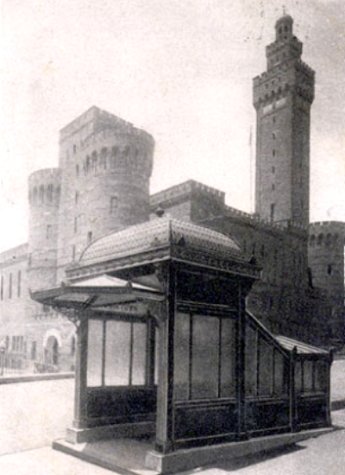
STEALING A GLANCE at the photo above, the viewer would easily be forgiven for mistaking the vista for that of a subway entrance in turn-of-the-century Siena, Italy. The proud medieval tower lurks over a comely metal-and-glass structure of continental flavor. However the city fathers of that ancient Italian municipality never deigned to erect an underground railway. The precise locus of the vista is far removed: it is the corner of Park Avenue and 33rd Street, and the building behind the subway entrance is not the town hall of Siena, but rather the armory of the 71st Regiment, New York National Guard.
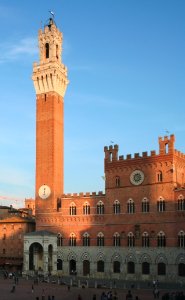 When the earlier Romanesque Revival armory of the Seventy-First Regiment burnt down in 1902, it was decided to build the new armory on the same, though slightly enlarged, site. The 1905 construction was built to the design of the architectural firm of Clinton and Russell, and was clearly inspired by the Palazzo Pubblico (the town hall, photo at right) of Siena, on that city’s Piazza de Campo. While the Seventh Regiment Armory contains the finest interiors of any military building in City, and probably the entire Empire State, the exterior of the Seventy-First’s armory was far superior. Even though the interior was not to the same lofty standard as the Seventh, it was by no means lacking, for it had all the wood-panelled rooms filled with military regalia from times gone by which one expects of New York’s armories from the period. (more…)
When the earlier Romanesque Revival armory of the Seventy-First Regiment burnt down in 1902, it was decided to build the new armory on the same, though slightly enlarged, site. The 1905 construction was built to the design of the architectural firm of Clinton and Russell, and was clearly inspired by the Palazzo Pubblico (the town hall, photo at right) of Siena, on that city’s Piazza de Campo. While the Seventh Regiment Armory contains the finest interiors of any military building in City, and probably the entire Empire State, the exterior of the Seventy-First’s armory was far superior. Even though the interior was not to the same lofty standard as the Seventh, it was by no means lacking, for it had all the wood-panelled rooms filled with military regalia from times gone by which one expects of New York’s armories from the period. (more…)
King Jagiello of Poland
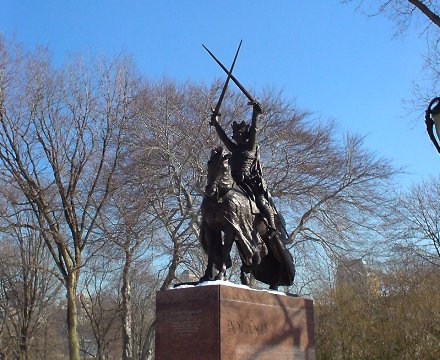
My favorite statue in Central Park is that of King Władysław II Jagiełło of Poland, by the Turtle Pond. (more…)
The Greatest Building Never Built

LUTYENS’ SCHEME FOR the Metropolitan Cathedral of Christ the King, Liverpool is oft hailed as the greatest building to never have been built. Strictly speaking, this is not accurate, as the building was structurally finished, although not completely decorated, up to the crypt level. Nonetheless, had it been finished, the cathedral almost certainly would have been considered Sir Edwin Lutyens’ greatest work; though his hand (with Herbert Baker) in building the Indian capital of New Delhi, including the monumental Viceregal Palace, would certainly vie for the title. (more…)
A Morning’s Journey
I crossed the Harlem River into Manhattan today just as Patrick Leigh Fermor traversed the Danube in his brilliant book, A Time of Gifts, which has immediately become one of my favorite reads of all time. Settling into my seat on the train yesterday, I opened my knapsack to utter shock and surprise—I had left my reading at home. The Leigh Fermor and P.G.W.’s Cocktail Time were resting somewhere in my bedchamber while I stared into the compartment of my bag, bare but for a photocopied page from the Art Newspaper and two (already-read) issues of the Hungarian Quarterly. These are the times that try men’s souls. Getting out of the city late in the evening proved even harder, as the bridge carrying the railway over the river was actually up for once (“First time in my life, folks,” the conductor informed us), leaving a steady backlog of trains awaiting their northerly destinations.
But this morning there were no bridge-raising complications, and the sky was a delightful, clear blue (soon to change) as we entered Manhattan. Thankfully, I had my two books; a bit of Wodehouse while waiting in Bronxville station and then Paddy Leigh Fermor on the train. After crossing the river, the train stops at 125th Street (Harlem) before submerging at 96th, taking the passenger down to Grand Central, that well-kept remnant on 42nd Street, reminding us that we too were once civilized. There, after taking a stroll through the market (Nürnburger sausage! Kaiser ham! Norwegian salmon!) you switch to the subway and hop down just one express stop on the 5 train.
Just half a dozen steps after emerging from Union Square station I saw a speck of white fall from the sky, and then another, and another. So it began: the first snowfall of the year. And, I might add, a New York record for the latest snowfall. (January 10th? No, there was no white Christmas for us this year). Two children on the swings in the playground ecstatically proclaimed their approval at the opening of the heavens. Wandering through the farmer’s market in the square, I picked up an herb focaccia bread I thought might be particularly enjoyable, and it complimented the exceptionally tasty Tuscan vegetable soup I had for lunch. The snowflakes swirled above the square and fell down on all the market-goers and the folks walking on Broadway as I marched up to work. And yet, how fleeting! In the few steps from the front door to the elevator, the white snow had already melted and merged into the green of my loden coat. Very well, Mother Nature. Very well.
Argentina’s Henley
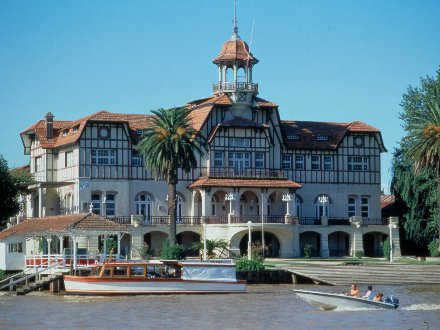
JUST NORTH OF Buenos Aires lies the city of Tigre. The city sits on the southern edge of the series of rivers, rivulets, islands, and eyots collectively known as the Parana Delta, after the Rio Parana which breaks up as it reachs the Rio de la Plata. The town’s riparian geography combined with its closeness to Buenos Aires—a mere twenty miles from the Obelisco—make Tigre a popular weekend and summertime getaway. Since the 1870s, however, it has also been the birthplace and focal point of rowing in the country—Argentina’s Henley. (more…)
Christmas
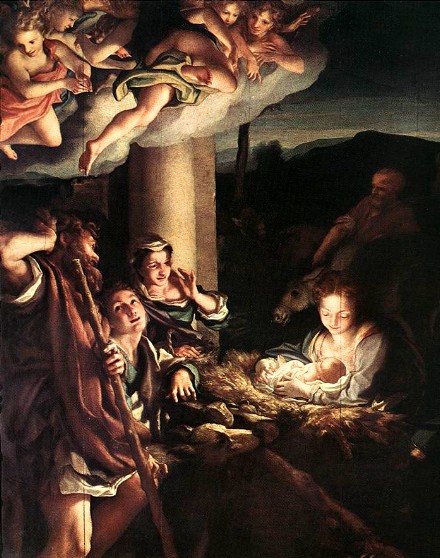
Corregio, Nativity
Oil on canvas, 101″ x 74″
1528-30, Gemäldegalerie, Dresden
Who with His life, the world to save,
All honor, power, glory, Thine,
and in Thy Heart our souls do bind.
a very merry and blessed Christmas.
Christmas Book List
Mr. and Mrs. Peperium over at Patum Peperium asked a few of their genial friends to come up with a Christmas book list, and we were more than happy to oblige. Interestingly enough, the only overlap was Guy Stair Sainty’s giant two-volume opus, which was both on my list and on Fr. M.’s list. I have reproduced my list below for your perusal.
 Well, first up, the books you can’t even get yet, not because they’re out of print but, rather, because they’re not exactly in print yet.
Well, first up, the books you can’t even get yet, not because they’re out of print but, rather, because they’re not exactly in print yet.
The Dangerous Book for Boys by Conn and Hal Iggulden has proved a roaring success amongst discriminating readers in the British Isles. The nifty book is basically a handbook for life, describing in detail how to win at conkers and learn the rules of cricket as well as providing information about major battles of history, NATO’s phonetic alphabet, the golden age of piracy, and that trickiest of all subjects:girls. The book’s out in Britain, Australia, and New Zealand, we North Americans will have to wait until May of next year.
Another book the Brits have already is Michael Burleigh’s Sacred Causes: The Clash of Religion and Politics from the Great War to the War on Terror, the sequel to Burleigh’s brilliant Earthly Powers: The Clash of Religion and Politics in Europe from the French Revolution to the Great War. In the first book, Burleigh brilliantly outlined the “long nineteenth century” as historians call it, depicting in detail the interplay between faith, reason, and power on the Mother Continent. Sacred Causes promises to bring us from the First World War all the way to the current so-called “War on Terror”, and we expect it will be done with the same precise, detailed, though occasionally light-hearted spirit which Burleigh has mastered. The book will be available on these verdant shores from March of next year.
While we’re traveling across the Atlantic, why not explore the British roots of our American society? In America’s British Culture, the late great Russell Kirk explores the Britannic foundations of the core of American culture and civilization. The book’s probably out of print, but can nonetheless be found here and there, and if not to purchase then there’s always the local library to try.
Far more perilous than a voyage cross the Atlantic is that most worrisome, tiresome, and pedantic of journeys: crossing the channel. To Belgium, or perhaps we should say “Belgium”, for after reading Flemish patriot Paul Belien’s A Throne in Brussels: Britain, the Saxe-Coburgs and the Belgianisation of Europe you will find the mere concept of “Belgium” repugnant. I picked up a copy of A Throne in Brussels and decided to give it a whirl despite finding the book’s title mostly uninteresting. After reading it, I also found the subtitle a little misleading. What Belien actually gives us is an overview of the history of “Belgium” which is both succinct and thorough, mostly focusing on the Belgian monarchy and its deep influence on the formation of this “nation” half-French and half-Dutch. It makes for a fascinating read of disgrace and debauchery as we’re told of the disgusting actions of, firstly the various kings of Belgium from the creation of the country ex nihilo in 1830, and then of astonishing Belgian cowardice and collaboration in the First and Second World Wars. However all this pales in comparison to the most telling, and the most disturbing, part of the book which tells us about modern, post-war Belgium. I will not reveal it’s contents but is truly, truly frightening. The point Belien posits as the crux of the book is this: I’ve told you about Belgium. Recall that the Eurocrats and their enthusiasts extol Belgium as the model for European unity; a single state in which communities of different blood and language live together in supposed harmony. If what I’ve written is true, then be afraid: be very afraid. And you will be.
Moving across the Continent, we stumble upon dear old darling Austria. The late Gordon Brook Shepherd was a devoted admirer of the Austrian people and nation, and this is exhibited in a number of the fine, well-crafted books he wrote. The Last Hapsburg is a very good biography of the Blessed Emperor Charles of Austria-Hungary, the last to rule over that many-peopled realm. It reads as a chronicle of simultaneous hope and decline, and the chapters detailing the Emperor’s two attempts to regain his Hungarian throne are action-packed and read like a spy thriller. Prelude to Infamy, meanwhile, deals with that last great figure of Austrian tradition and reaction, Chancellor Engelbert Dollfuss. Brook Shepherd gives a splendid overview of Dollfuss’s early life and upbringing, his rise to power, and his eventual downfall at the hands of Hitler’s henchmen. Both these books are well worth reading, but I am also intrigued by the title alone of Brook Shepherd’s biography Between Two Flags: The Life of Baron Sir Rudolf von Slatin Pasha, GCVO, KCMG, CB, on which I have not yet been able to lay my hands.
Travelling deep within Europa’s belly are Patrick Leigh Fermor’s chronicles of his journey through Ruritania at the young age of twenty-two in the period between the wars when a great deal of the old order still remained. This meandering tramping trip, from London to Constantinople, is retold to us in Sir Patrick’s A Time of Gifts, considered a classic in the travel genre, and Between the Woods and the Water.
On his journey, Fermor came across a number of Europe’s aristocrats, nobility, and titled gentry. No doubt many-well, all really-of the honours and orders which bedecked their chests can be found in Guy Stair Sainty’s brand spanking new World Orders of Knighthood & Merit, out this year from Burke’s Peerage. The two volumes weigh in at twenty pounds imperial, containing two thousand pages and yours for a mere $375.
Cheaper, smaller, and infinitely more full of vim and moxie, however, is the delightful little picture book Simple Heraldry Cheerfully Illustrated by Sir Iain Moncrieffe of That Ilk, with truly cheerful illustrations by Don Pottinger. Both Moncreiffe and Pottinger served Her Majesty in the Court of Lord Lyon, Scotland’s heraldic authority, and the book is chock-full of delightful little explanations of the various aspects of heraldry, simplified and in digestible form.
But rememeber man that thou art dust and unto dust thou shalt return. If you’re lucky, that dust will be guarding the covers of the splendid Very Best of the Daily Telegraph’s Books of Obituaries which contains myriad tales of those individuals whose lives have been compacted onto the obituary page of Great Britain’s quality daily. Even more interesting is the more specific Daily Telegraph Book of Military Obituaries, containing various anecdotes of mess, ball, parade ground, and battlefield. How sad are the days when the only place one reads of class, dignity, and wit are the obituary pages! Or, as a friend puts it rather more alarmingly: every day more and more war veterans die off, while more and more products of government schools are unleashed into the world.
Yet our end ought to be a cheerful one, so catch up with that Grand Old Man who has since gone to join the Choir Invisible. The brilliant writings of Peter Simple are collected in a number of different volumes, most notably Peter Simple’s Century, which I warmly encourage the reader to purchase at the nearest opportunity. Better yet, make it two and forward one to me.

The Vicar’s Remorse
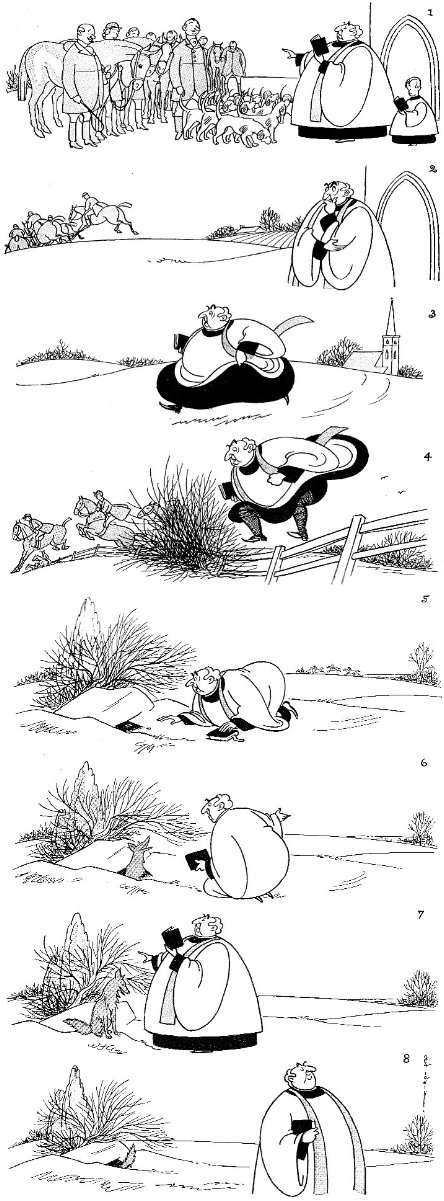
Previously: New York in November | The New Yorker Hunts | Tally Ho, Empire State!
Governors Island Revisited
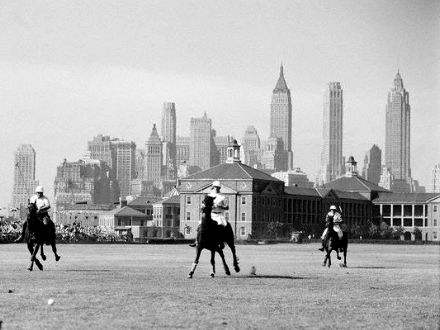
EVERY ONE OF THE myriad plans put forth for the ‘redevelopment’ of the venerable old Governors Island in New York Harbor has so far either stalled, been neglected, or otherwise poo-pooed. In this, we have something to rejoice. As I have often said, realistically speaking there is little that can be done to it which will not neglect or disgrace the island’s long military heritage. The officially-approved ideas put forth so far have been horrific: an amusement park, a casino, a ‘technology park’, as well as a number of other vapid proposals.
Naturally, we’d be enthused if it returned to its former role as swankiest post in the entire Army and the home of Army polo, but don’t hold your breath. West Point being the single exception, if it has even a touch of history, tradition, or class, Congress and the Department of Defense will do their best to get rid of it. After all, the National Guard has been pulled out of the Seventh Regiment Armory, the Navy has withdrawn all but a few institutions from Newport, and the Army has left the ancient Presidio of San Francisco; how long will it be until Fort Leavenworth’s foxhounds are brought out back and shot by the Monotony Monitors? (more…)
Peter Simple IV
Affairs of state bother us often, and they even intrude into the mind of such worthies as that grand old man, Peter Simple. These two columns, the fourth in our series attempting to introduce you to the most brilliant columnist who ever was, deal with precisely such subjects: one foreign, and one domestic. The first was written in 2002, as Paddy Ashdown, the former leader of the Liberal Democrats (ennobled as Baron Ashdown of Norton-sub-Hamdon) was appointed to the post of ‘High Representative for Bosnia and Herzegovina’, a sort-of viceroyship created by the United Nations to keep an eye on wayward Balkan peoples. In ‘Glory’, Mr. Simple reflects upon the prospect. Reprinted below that is another example of ‘What the Papers Say’, in which, speaking through the editorial pages of the Feudal Times and Reactionary Herald, Peter Simple implores us to take a serious look at House of Lords reform. As per usual, his proposals are right on target.
Glory
 THEY say that Paddy Ashdown, the great Liberal leader, is to be given high office in Bosnia, as governor, no less. It will not be long, we monarchists all hope, before he is offered the crown and ascends the throne of Bosnia as King Paddy the First. The last king of Bosnia, Steven VII Tomasevic, surrendered to the Turks and was beheaded in 1463. But times have changed, and this should not necessarily be a precedent.
THEY say that Paddy Ashdown, the great Liberal leader, is to be given high office in Bosnia, as governor, no less. It will not be long, we monarchists all hope, before he is offered the crown and ascends the throne of Bosnia as King Paddy the First. The last king of Bosnia, Steven VII Tomasevic, surrendered to the Turks and was beheaded in 1463. But times have changed, and this should not necessarily be a precedent.
Approached by a joint delegation of the Serb, Croat and Muslim communities, he will at first pretend to put the crown aside, then yield to their urgent pleas. How glorious, when in Sarajevo, at a ceremony with specially devised ecumenical rites (Catholic, Greek Orthodox, Muslim, Methodist, agnostic, humanist, Salvation Army), the Secretary-General of the United Nations, Kofi Annan himself, places the crown on his head.
Loud the people’s acclamations, loud the pealing organs and massed choirs with all the bells of Sarajevo ringing out as leaders of the three communities swear allegiance! Later, he inspects a guard of honour of the happily named Nato Dissuasion Force, then tours the city.
His piercing blue eyes, screwed up with almost intolerable sincerity, scan the remotest forests and reactionary mountains for signs of emerging liberalism. Peasants in their picturesque costumes have trooped in from the countryside, bearing traditional gifts: ornamental daggers, pots of honey, embroidered shawls, clotted cream and new-laid eggs.
Folk songs mingle with the strains of “He’s A Jolly Good Fellow”, “Follow The Van” and (an allusion to the new monarch’s Irish ancestry) “If You’re Irish, Come Into The Parlour”. Helicopter gunships and squadrons of fighter aircraft fly past as the King chats easily to his people. They laugh heartily at well-chosen anecdotes of his time as Liberal leader. Distant explosions mark pockets of resistance, to be mopped up by the Bosnian army. He orders the search for “war criminals” – slab-faced Mladic and tousle-headed Karadzic – to be intensified.
As night falls, dense fumes of slivovitz hang over the sleeping city. A sound of massed snoring comes from the Royal Palace, where King Paddy sits at ease, regaling his courtiers with extracts from his Liberal party conference speeches and statements of liberal ideals: the need for dialogue and for a determined but carefully considered step forward into the future.
What the Papers Say
In a thoughtful leader, the Feudal Times and Reactionary Herald discusses reform of the House of Lords: “Since the arbitrary and unlawful expulsion of most hereditary peers from the Lords, those of our readers who lost their seats, as well as those few who retain them, may be inclined to regard any further suggestions for ‘reform’ with indifference and contempt.
“Debates on this subject both in the Lords itself and in the Commons may indeed have exhibited a level of inanity unusual even for those sadly degenerate bodies. Yet their very persistence in ignoring the real issues should only strengthen our own determination to confront them.
“In a recent debate, some speakers favoured an Upper House entirely elected; some an Upper House entirely appointed; some a mixture of elected and appointed members. Others, typical adherents of the foaming radical and contumelious schoolteacher tendency, wanted to abolish the Upper House altogether.
“Not one single speaker in either house suggested that the best measure of ‘reform’ would be to scrap the present hybrid assembly, including those chimerical figures, the so-called ‘life peers’, and, by retaining the remaining 92 peers and bringing back the 600 so outrageously expelled, restore the House of Lords which existed so satisfactorily for hundreds of years.
“We believe that a firm, uncompromising assertion of the hereditary principle would not only dispose of further futile argument but would be greeted with relief and enthusiasm by the still sound majority of English people, who, we dare aver, remain true in their hearts to the old beliefs which made our country great, and our Parliament the wonder and envy of the world.”
Search
Instagram: @andcusack
Click here for my Instagram photos.Most Recent Posts
- Amsterdam November 26, 2024
- Silver Jubilee November 21, 2024
- Articles of Note: 11 November 2024 November 11, 2024
- Why do you read? November 5, 2024
- India November 4, 2024
Most Recent Comments
- on The Catholic Apostolic Church, Edinburgh
- on Articles of Note: 11 November 2024
- on Articles of Note: 11 November 2024
- on Why do you read?
- on Why do you read?
- on University Nicknames in South Africa
- on The Situation at St Andrews
- on An Aldermanian Skyscraper
- on Equality
- on Rough Notes of Kinderhook
Book Wishlist
Monthly Archives
Categories

